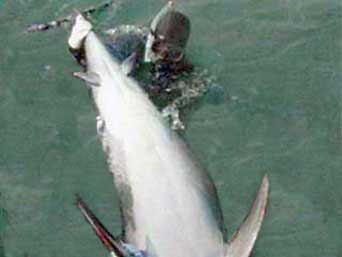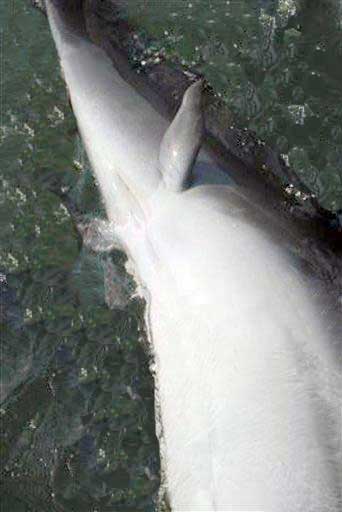Cetacean Evolution (Whales, Dolphins, Porpoises)
Evidence of Common Ancestry of Cetaceans and Certain Species of Land Mammals
by Edward T. Babinski
(Reviews of several creationist articles that deny such evidence exists.)
REVIEW OF "The Strange Tale of the Leg on the Whale" by Carl Wieland
The author of the above article denies that the vestigial pelvic bones in modern day whales (which are also found in other cetaceans like dolphins and porpoises) is a vestigial pelvis. He writes: "They [evolutionists] believe this even though these strips of bone have a known function [to anchor the male reproductive organ], differ in males and females, and are not even attached to the vertebral column." The author apparently does not consider that vestigial organs can also be put to new and different uses which is one of the hallmarks of nature's jury-rigged ways. And the fossil record of early whales includes one with a tiny pelvis and tiny rear legs (Basilosaurus) possibly used to aid in copulation, so the adaptation of the vestigial pelvis bones in modern whales (as an anchor for the penis) seems to have an evolutionary pedigree. The fossil record of whales eventually includes critters with a pelvis that no longer articulates with the vertebral column. So the identification of those small bones in whales / dolphins / porpoises as a "vestigial pelvis" suggests itself rather neatly. (Interestingly, outside of the whale family, snakes have puny vestigial pelvis bones too, where the pelvises of their ancestors used to be.) The author denies that "vestigial femurs" which are found where a femur would normally be located (near, or attached to the whale pelvis and pointing downward on both sides of the pelvis) are "vestigial femurs." He says these are perhaps DNA malfunctions or signs of bone disease. The author includes a section titled, "Myth Tracked Down," concerning the story in a Danish science textbook (E.J.Slijper, Whales) about a bump identified as a "tibia" on a Sperm whale. The author calls the "tibia" identification a "myth." Actually such "myths" have been documented with X-Rays according to A. V. Yablokov, Variability of Mammals (1974) who examined a number of such discoveries personally after they were discovered at whale factories in Russia. There were different varieties of such "bumps" that were found to contain remnants of a femur, remnants of a femur and the metatarsus, and, in some cases even remnants of a femur, metatarsus and phalanges [toe bones]. As for Yablokov's first hand testimony, it is not the only one: "There are many cases where whales have been found with rudimentary hindlimbs in the wild (for reviews see Berzin 1972, pp. 65-67 and Hall 1984, pp. 90-93). Hindlimbs have been found in baleen whales (Sleptsov 1939), humpback whales (Andrews 1921) and in many specimens of sperm whales (Abel 1908; Berzin 1972, p. 66; Nemoto 1963; Ogawa and Kamiya 1957; Zembskii and Berzin 1961). Most of these examples are of whales with femurs, tibia, and fibulae; however, some even include feet with complete digits."
Nor does the author mention whale embryology : "Modern adult whales, dolphins, and porpoises have no hind legs. Even so, hind legs, complete with various leg bones, nerves, and blood vessels, temporarily appear in the cetacean fetus and subsequently degenerate before birth." Amasaki, H., Ishikawa, H., and Daigo, M. (1989) "Developmental changes of the fore-and-hind-limbs in the fetuses of the southern minke whale, Balaenoptera acutorostrata." Anat Anz 169: 145-148. [PubMed]

TOKYO Nov 5, 2006 (AP), Japanese scientists reported a bottlenose dolphin, has an extra set of fins that could be the remains of hind limbs. The dolphin was captured alive in western Japan on Oct. 28, by Fishermen. "I believe the fins may be remains from the time when dolphins' ancient ancestors lived on land," said Seiji Osumi, of Tokyo's Institute of Cetacean Research. The hind fins are much smaller than the front fins and are about the size of human hands, protruding near the tail. The dolphin measured approx 9 feet in length.
- Dolphin May Have 'Remains' of Legs, Evidence Ocean Mammals Lived on Land
- A Dolphin with Hind Limbs, Science Blogs
- Dolphin May Have 'Remains' of Legs, Associated Press
- Answers In Genesis Response to Dolphin Hind Limb Discovery
- Response to AiG's Response on Dolphin Hind Limbs




No comments:
Post a Comment